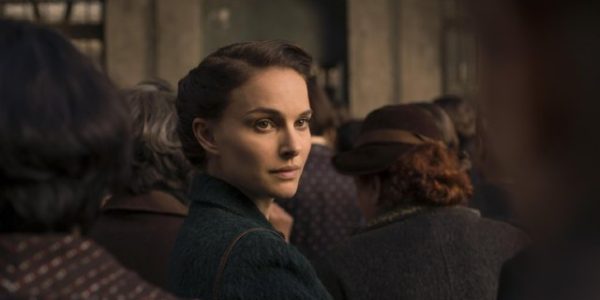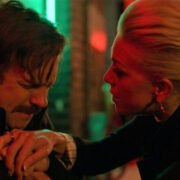A TALE OF LOVE AND DARKNESS: Natalie Portman Astounds In Her Directorial Debut

Zachary is studying film at the University of Southern California,…
I’ve long been impressed and inspired by Natalie Portman – she has an undeniable gift for screen acting. I also have an immense amount of appreciation for writer-director-actors, as working in all three creative spaces is my primary career goal. Naturally, when Portman decided to take on all three creative roles for a film, I was beyond intrigued and excited to see the project in question.
Israeli novelist and peace activist Amos Oz’s autobiographical memoir, A Tale of Love and Darkness, is the book that Portman adapts for her screenwriting and directorial debut, in which she plays the mother of Oz – Fania. The film focuses on the portions of the book dealing with Oz’s childhood and relationship between mother and son, during the transition from British Mandate-occupied Palestine to the then-newly created Jewish State, along with turbulent times in Israel thereafter. The film is a family’s story, set against this historical backdrop.
Building from Book to Portman to Film
Portman herself is Jewish and was born in Jerusalem. At a young age, her family brought her to the United States. After being recognized for her talent in New York at the age of 11, she starred opposite Jean Reno and Gary Oldman in her first film, Leon: The Professional, directed by the French great, Luc Besson – the rest, as they say, is history. Her work under the best directors around, ranging from Tim Burton to George Lucas, Michael Mann, Darren Aronofsky, Anthony Minghella, Terrence Malick, Kenneth Branagh, Mike Nichols, Wes Anderson, and Woody Allen, no doubt gave her a range of examples of directorial styles both aesthetically and practically (in terms of running a set) – such examples could include aspects she wished to incorporate into her own, or styles she would choose not to incorporate.

She read Oz’s book as soon as it was available in translation, and over the course of ten years, she knew she’d be the one to direct an adapted film of it. When she read the book, she saw the film in her mind. It resonated with her, as the time period of Oz’s childhood is one she heard endless stories of from her grandparents, who lived in Israel at the time.
Thus, the backdrop in her film is something that has lived in her imagination since her childhood. She got Oz’s permission to make the film, and started to meet with screenwriters to adapt it, but they all recognized she had a clear vision for the project. Some even suggested she write it, which she then did. Playing Oz’s mother Fania was not initially on Portman’s mind, as she was too young for the role when she first pursued making the film. As time went by, she aged into being able to play the role.
The Look of Love and Darkness
The film is beautifully constructed, and includes narration from elder Amos Oz (played by Moni Moshonov) interspersed throughout. The opening shows what is a common occurrence throughout the film, Fania (played by Natalie Portman) is at the bedside of young Amos (played by Amir Tessler, a remarkable discovery of talent, not unlike the discovery of Portman at the start of her career), telling him a story before he goes to sleep. Fania’s stories often involve her, Amos, or the both of them, and are rendered visually in spellbinding ways – with the capable work of Portman’s DP, a legend in his own right, Slawomir Idziak (best known for Gattaca and Harry Potter and the Order of the Phoenix, though he has an enormous career predating those, during which he shot innumerable films in his native land of Poland).

They shot digitally on ARRI Alexa and Blackmagic Pocket Cinema Cameras, allowing for inky blacks populating a sometimes bleak landscape in Israel. Idziak’s framing is elegant. Many times during the fil m, I was taken aback, whether by simple shots that positioned the actors for artful compositions, or by clever landscapes in which the storytelling sequences take place.
Without revealing what transpires within, several of the stories Fania tells Amos work as striking and poignant metaphors for the overall arc of their bond, and thus, the film as a whole. This is where Natalie Portman gets poetic, and by the end, once the metaphoric meanings sink in, it really resonates. It’s no surprise that a boy whose mother communicated vast and hard truths to him via bedtime stories ended up a writer of stories himself, using his own storytelling to explore his upbringing in his memoir, which Portman expertly mines for the film.
Portman, directing a DP for the first time (outside of some short films) demonstrates a striking eye for (and attention to) detail. Notice how some shots linger on unconventional visuals, hands gesturing while a story is being told, or when food is being prepared. What could be either arbitrary inserts, or foregone in the favor of wider, all-encompassing shots, instead point out nice, small details. Notice also the occasional shots from the point of view of younger Amos, further working to link the viewer to him, and his experience of the world. It is in this visual device, and in the general positioning of the spectator with Amos, that Portman tells a story of great specificity of time, place, and from one person’s worldview. Despite this, she constructs a film with a striking degree of relatability and universality. In a fascinating interview with Charlie Rose about the film, Portman quoted the words of Oz. He once stated that “what is the most specific, is in fact is the most universal”.

Aside from the device of elder Amos’ narration, the transportive storytelling sequences, including a tale of two monks traveling the country under a vow of silence who come across a woman in peril, a woman who leaves an abusive husband for her lover, and a military officer who lived with Fania’s family when she was a child, Portman’s film also employs the device of the Hebrew language. Oz’s father, Arieh (played by Gilad Kahana) writes about literature, and often tells his son of the etymologies of various Hebrew words, pointing out the links between the Hebrew words for man, earth, the color red, blood, and silence, as well as the link between the word for go forward and the past – so Arieh says, in order to go forward, the Hebrew thinker must go into his past. Oz clearly put a lot of thought and effort into the construction of his novel, and Portman shows loving fidelity to this with her film.
A Score of Love and Darkness
The film’s score is a masterwork by Nicholas Britell, currently receiving great and deserved acclaim for his score for Barry Jenkins’ Moonlight. Working near-exclusively with piano elements, Britell amplifies the film’s anguish and genuinely sentimental core, sometimes with an unexpected childlike whimsy, playing into young Oz’s age, but contrasting with the dark happenings around him and his parents. One particular sequences soars with Britell’s music behind it, this sequence is undoubtedly the film’s saddest.
Another focus of Oz’s novel, and the film, is the notion of dreams. While Portman has stated that she does not agree with Oz’s sentiment, that actualizing a dream always breeds disappointment, she retains this as a central message of the film’s story. It materializes in a number of ways throughout the film, and Portman does admit that a realized dream, while not always disappointing, is always different in actuality than it was in one’s mind, something she compares to the dream this film represented for her, and what the finished film became.
She demonstrates a knack for visual storytelling, and an ability to not just give a great performance, but to get great performances out of her cast. A Tale of Love and Darkness is a sincere, heartfelt, and enormously emotionally impactful viewing experience, and is one of my favorite films released in 2016. I highly recommend you seek it out.
Did you know that Portman wrote, directed and starred in a film, before she was Jackie? Tell us your thoughts in the comments below.
A Tale of Love and Darkness is now available on iTunes, Amazon, and is available on DVD on March 28th.
Does content like this matter to you?
Become a Member and support film journalism. Unlock access to all of Film Inquiry`s great articles. Join a community of like-minded readers who are passionate about cinema - get access to our private members Network, give back to independent filmmakers, and more.
Zachary is studying film at the University of Southern California, in Los Angeles. He is enamored with blockbuster films (both the hits and the flops) and the tech, toys and tools that go into making them. He aspires to bring an indie sensibility to big films in his career as a writer/director/actor, and looks to writer/director/actors like Jon Favreau and Ben Affleck for inspiration. He is notorious for appreciating films that the masses seem to loathe, and loves film scores and composers. While he loves the big movies, he also loves a good indie (and shouting to the heavens above about said indie). He may or may not have a penchant for collecting Blu-rays, and when not writing/making/talking/reading/listening to film-related material, he likes to do other stuff... like watch TV (and perhaps other things as well).











